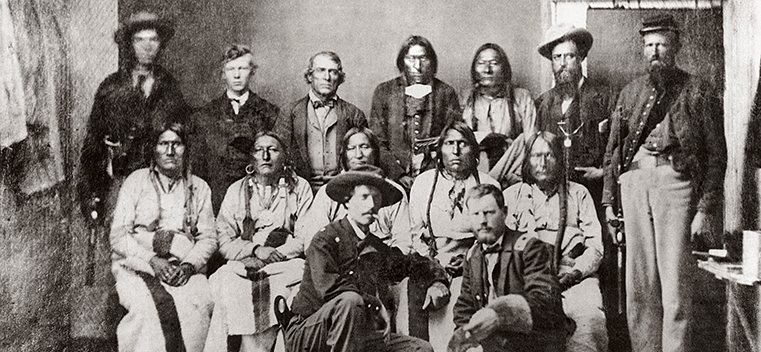
John Evans and the Sand Creek Massacre
View the full "Report of the John Evans Study Committee" in a PDF.
Tell us what you think. E-mail comments or questions to the editors at letters@northwestern.edu.
Ever wonder about those strange designations we use throughout Northwestern to identify alumni of the various schools of the University? See the complete list.
Find Us on Social Media
Committee releases study on involvement of leading University founder in the 1864 massacre of Native Americans.
An independent committee of scholars released an extensive study of the involvement of John Evans in the Sand Creek Massacre and in the history of Northwestern University in May. The massacre, in which U.S. Army cavalry soldiers slaughtered approximately 150 Cheyenne and Arapaho Native Americans, most of them women and children, occurred on Nov. 29, 1864, in southeastern Colorado. Evans was the governor and superintendent of Indian Affairs of the Colorado Territory and was traveling in the East at the time of the massacre. He was forced to resign in its aftermath.
Evans was one of Northwestern’s founders, chair of its Board of Trustees for more than 40 years and a major donor to the University. The city of Evanston is named for him.
The report is the work of a committee of eight senior scholars from both Northwestern and outside the University. Carl Smith, Northwestern professor emeritus of English, American studies and history, chaired the group.
Following are the conclusions, as stated in the report:
• No known evidence indicates that Evans helped plan the Sand Creek Massacre or had any knowledge of it in advance. The extant evidence suggests that he did not consider the Indians at Sand Creek to be a threat and that he would have opposed the attack that took place.
• Evans nonetheless was one of several individuals who, in serving a flawed and poorly implemented federal Indian policy, helped create a situation that made the Sand Creek Massacre possible. In this regard, the most critical of his errors was his failure to fulfill his responsibility as superintendent of Indian Affairs to represent the best interests of Native people in Colorado. The most significant instances of this failure were his response to the skirmishes that occurred in the spring of 1864 and, especially, his conduct during and following the Camp Weld meeting [a conference with Cheyenne and Arapaho leaders who were seeking peace] in late September.
• Evans’ conduct after the Sand Creek Massacre reveals a deep moral failure that warrants condemnation. While he denied any role in the massacre, he refused to acknowledge, let alone criticize, what had happened, even going so far as to defend and rationalize it. Regardless of Evans’ degree of culpability in failing to make every possible effort to protect the Cheyennes and Arapahos when they were most vulnerable, his response to the Sand Creek Massacre was reprehensibly obtuse and self-interested. His recollections of the event displayed complete indifference to the suffering inflicted on Cheyennes and Arapahos.
• Evans did not profit from the Sand Creek Massacre. On the contrary, the massacre cost him both politically and financially. He did profit in a broader sense from his policies toward Indians when he was governor, however, since in the years that followed he was a full participant, along with many others, in the effort to develop the western and national economies that was profoundly damaging to Native people and remunerative to individuals like himself.
• Although quantifying the portion of Evans’ substantial contributions to Northwestern that resulted from his policies toward Native peoples is difficult, such a connection existed. The University should recognize that, just as Evans profited from the development of the western and national economies in the late 19th century, so did Northwestern and many other institutions.
• Evans deserves institutional recognition for his central and indispensable contributions to the establishment of Northwestern and its development through its early decades, but the University has ignored his significant moral failures before and after Sand Creek. This oversight goes against the fundamental purposes of a university and Northwestern’s own best traditions, and it should be corrected.
The committee’s investigation included a visit to the massacre site in southeastern Colorado, research in numerous archives and libraries and discussions with other scholars. The research effort took more than a year.



 Facebook
Facebook Twitter
Twitter Email
Email


